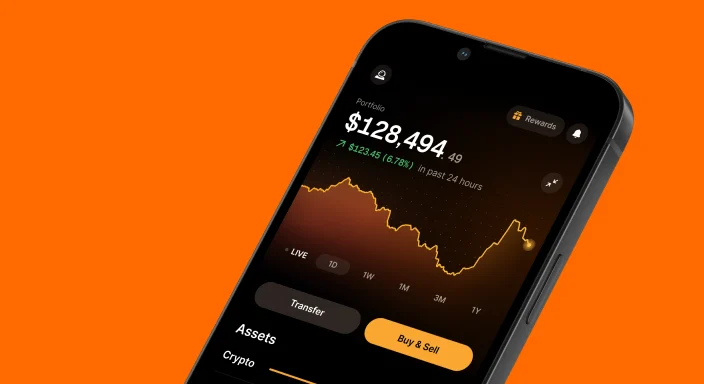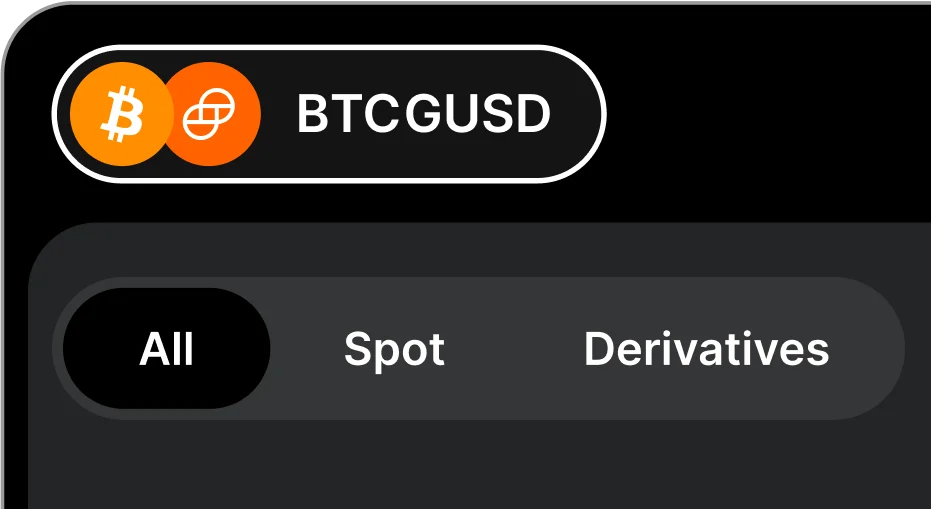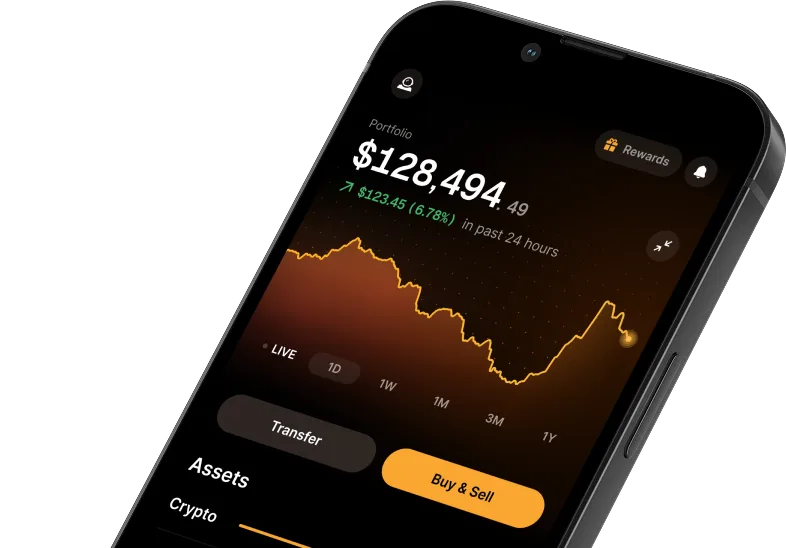Bitcoin (BTC) Price
Bitcoin
BTC
$85,869.61
-$108.05 (-0.13%)
LIVE
Volume (24H)
$36.2M
Circulating Supply
19.96M
Market Cap
$1.714T
About Bitcoin (BTC)
Bitcoin is the world’s first cryptocurrency and blockchain. Bitcoin is the first decentralized digital currency, meaning bitcoins are transferred peer-to-peer over the Internet without needing to be passed through a bank or other financial institution. This results in lower fees, international accessibility, and avoidance of restrictions and limits traditionally imposed by financial institutions.
Buy BTC
0.000058 BTC
$100
$500
$1000
$5000

Download the
Gemini Mobile App

Refer friends, earn crypto.
Invite friends to Gemini and you’ll both earn $50 in crypto when your referral trades $100 in their first 30 days.
Trending Tokens

Gemini ActiveTrader®
Trade Bitcoin on the platform designed and built for traders
Trending Tokens
About Bitcoin (BTC)
Bitcoin is the world’s first cryptocurrency and blockchain. Bitcoin is the first decentralized digital currency, meaning bitcoins are transferred peer-to-peer over the Internet without needing to be passed through a bank or other financial institution. This results in lower fees, international accessibility, and avoidance of restrictions and limits traditionally imposed by financial institutions.
Bitcoin Blogs
Bitcoin Cryptopedia articles
Bitcoin links and resources
The whitepaper
Bitcoin website
Frequently asked questions
What is the difference between Bitcoin (capitalized) and bitcoin?

When Bitcoin is capitalized, it refers to the concept of bitcoin, including its technology, protocol, software, etc. When bitcoin is uncapitalized, this refers specifically to the bitcoin unit of currency (BTC) known as a digital asset token.
How does Bitcoin work?

Bitcoin exchanges allow users to buy and sell bitcoins (BTC) in their native currency. Bitcoins are stored in a bitcoin wallet, which is a secure, digital storage program designed to store keys for crypto transactions that live on your desktop computer or mobile device. Bitcoin buyers and sellers make up a peer-to-peer network and the individuals who verify transactions are known as miners. Verified transactions go into a public record on the blockchain called a ledger.
Are Bitcoin Transactions Anonymous?

While Bitcoin transactions are harder to trace than traditional electronic transactions, they are not completely anonymous. Miners can use pseudonyms, but your crypto wallet’s address (a unique string of numbers and letters) is stored in the public blockchain. This enables fraud prevention as transactions can be publicly traced. So in a sense, yes bitcoin transactions are anonymous in that your name is not immediately identifiable. However, your bitcoin wallet ID is.
What are the Advantages of Using Bitcoin (BTC)?

For businesses, accepting bitcoins (BTC) as payment is a free and easy way to minimize transaction fees and expand your customer base.
For miners, in addition to the convenience that Bitcoin offers as a paperless payment option, miners also earn newly created bitcoins each time they verify a transaction. The peer-to-peer and open-source nature of Bitcoin provides a secure, decentralized alternative to traditional banking that also offers an opportunity to have a direct impact on the future of Bitcoin as a cryptocurrency.
When is the Bitcoin Halving or Halvening?

The supply schedule of bitcoin is deflationary. This schedule — embedded in the Bitcoin protocol — dictates that every time a miner successfully writes a new block to the blockchain (i.e., solves the proof of work puzzle), that miner shall receive a set number of bitcoin called the "block reward." The Bitcoin protocol sets and adjusts the mining difficulty so that miners will be able to win the block reward roughly every 10 minutes. The block reward is how all new bitcoin are issued or minted, and how all bitcoin in circulation have come into existence.
Every 210,000 blocks — roughly every 4 years — the block reward is reduced by half, an event often referred to as the "the halvening" or “the halving.” When Bitcoin launched in 2009, the initial block reward was 50 bitcoin. On November 25, 2012, the first halvening occured, halving the block reward from 50 to 25 bitcoin. On July 10, 2016, the second halvening occured, halving the block reward from 25 to 12.5 bitcoin. On May 11, 2020, the third halvening occurred, halving the block reward from 12.5 to 6.25 bitcoin. On April 20, 2024, the fourth halvening occurred, halving the block reward from 6.25 to 3.125 bitcoin.
The block reward will continue to undergo halvings until it reaches 0. This is estimated to happen sometime in the year 2140. At this point in time, there will be a total of 21 million bitcoin in circulation.
What is the History of Bitcoin?

Bitcoin was first described in a white paper published by Satoshi Nakamoto in October, 2008. Nakamoto is believed to be a pseudonym for the individual or group responsible for Bitcoin as there is no record of a computer scientist by this name prior to the launch of Bitcoin in 2009.
At the time, Satoshi claimed to be a 37 year-old man living in Tokyo, Japan. The translation of his name offers interesting insights: satoshi means “clear-thinking” or “wise,” naka means “inside” or “relationship,” and moto means “the origin” or “the foundation.” Taken together, it could be translated as “thinking clearly inside the foundation.”
Satoshi continued to update the Bitcoin source code until 2010 and wrote hundreds of blog posts in flawless English totalling 80,000 words, roughly the length of a novel. Satoshis’ first post used American spellings, however, every subsequent post used British spellings and colloquialisms. His writing timestamps don’t point to any particular time zone.
On the 23rd of April, 2011, Satoshi disappeared from the Internet, telling a developer in an email that he has "moved onto other things." Whoever Satoshi is, he is considered a polymath who possesses extensive knowledge with respect to computer programming, economics, cryptography, and peer-to-peer networking.
Bitcoin was born during the 2008 Financial Crisis. To commemorate this moment in time, Satoshi embedded a Times of London newspaper headline into the metadata of the first block of the Bitcoin blockchain, known as the Genesis Block. It reads: “The Times 03/Jan/2009 Chancellor on brink of second bailout for banks.”
What are the Advantages of Bitcoin over Traditional Currency?

Using Bitcoin to complete transactions offers several advantages over more traditional transactions, including but not limited to:
Protection from fraud and reduced risk of identity theft - due to the public ledger and blockchain technology.
Permissionless, borderless transactions – as opposed to traditional currencies that require financial institution or government permission to use, bitcoins have no limits and can be used internationally. This also means that no one can confiscate your bitcoins. Bitcoin enables miners to ‘be their own bank’.
Avoidance of inflation – as Bitcoin has a capped supply at 21 million bitcoins which are generated at a predictable rate, this makes Bitcoin a deflationary currency.
Immediate settlement and no risk of chargebacks – Bitcoin relies on a push system, meaning that once a transaction has been verified, funds are settled immediately and there is no way to reverse it (similar to using paper money as opposed to a credit card).
The smallest subunit of BTC is the “satoshi,” which is named after Bitcoin’s pseudonymous creator, Satoshi Nakamoto. One satoshi is equal to 10-8 BTC or one hundred-millionth of a BTC (0.00000001 bitcoin). Bitcoin can be bought and sold for fiat currency or other digital currencies.
Bitcoin can be purchased on a cryptocurrency exchange and stored in a crypto wallet and custodian like Gemini.
Bitcoin Supply

Unlike other cryptocurrencies with unlimited supply like Ethereum (ETH), the supply of bitcoin is deterministic and fixed at 21 million BTC. The supply schedule is embedded in the Bitcoin protocol.
What is Bitcoin Pizza Day?

The bitcoin pizza refers to the first time bitcoin was used to purchase a real good. On May 22, 2010, a programmer in Florida named Laslo Hanyecz (now referred to as the “Bitcoin Pizza Guy”) purchased two Papa John's pizzas for 10,000 bitcoin; a day now referred to as Bitcoin Pizza Day. Initially, Laslo posted a message titled "Pizza for bitcoins?" on Bitcointalk’s Bitcoin Forum. An 18-year old named Jeremy Studivant responded under the handle “Jercos” and the two later consummated the transaction over Internet Relay Chat (IRC). Afterwards, Hanyecz exclaimed: "I just want to report that I successfully traded 10,000 bitcoins for pizza. Thanks jercos!"
Lalso paid for the two pizzas using bitcoin that he mined with his personal computer. At the time, the bitcoin that exchanged hands was valued at approximately $30 dollars. Since then, the value of that same amount of bitcoin has grown exponentially (worth over $90 million dollars as of May 22, 2020), making this the most expensive pizza ever purchased in the world. Every year on May 22, the Bitcoin community commemorates Bitcoin Pizza Day. This historical day highlights the deflationary nature of bitcoin and its store of value properties.
Learn more about Bitcoin on Cryptopedia

